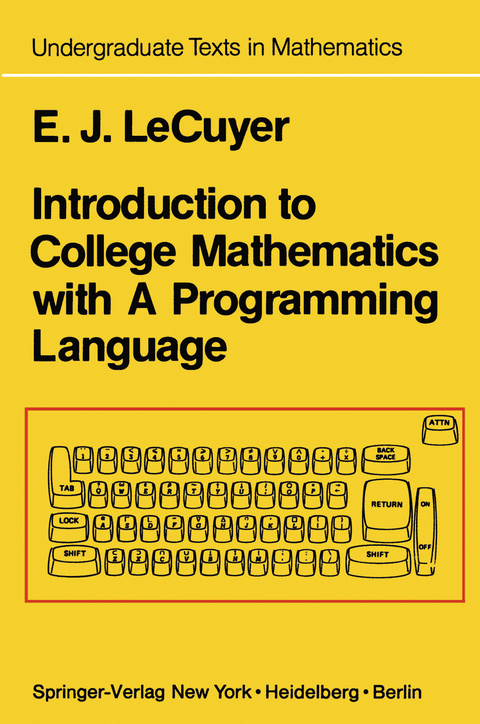
Introduction to College Mathematics with A Programming Language
Springer-Verlag New York Inc.
978-1-4613-9424-2 (ISBN)
The topics covered in this text are those usually covered in a full year's course in finite mathematics or mathematics for liberal arts students. They correspond very closely to the topics I have taught at Western New England College to freshmen business and liberal arts students. They include set theory, logic, matrices and determinants, functions and graph ing, basic differential and integral calculus, probability and statistics, and trigonometry. Because this is an introductory text, none of these topics is dealt with in great depth. The idea is to introduce the student to some of the basic concepts in mathematics along with some of their applications. I believe that this text is self-contained and can be used successfully by any college student who has completed at least two years of high school mathematics including one year of algebra. In addition, no previous knowledge of any programming language is necessary. The distinguishing feature of this text is that the student is given the opportunity to learn the mathematical concepts via A Programming Lan guage (APL). APL was developed by Kenneth E. Iverson while he was at Harvard University and was presented in a book by Dr. Iverson entitled A i Programming Language in 1962. He invented APL for educational purpo ses. That is, APL was designed to be a consistent, unambiguous, and powerful notation for communicating mathematical ideas. In 1966, APL became available on a time-sharing system at IBM.
1 Set theory.- 1.1 Sets.- 1.2 Operations with Sets.- 1.3 A set theory drill and practice program (optional).- 1.4 Boolean algebra.- 1.5 The number of elements in a set.- 2 Logic.- 2.1 Statements and logical operations.- 2.2 Conditional statements.- 2.3 Logical equivalence.- 2.4 Arguments.- 3 Vectors and matrices.- 3.1 Vectors.- 3.2 Operations with vectors.- 3.3 Matrices.- 3.4 Operations with matrices.- 3.5 Properties of matrices.- 4 Systems of linear equations.- 4.1 Linear equations.- 4.2 Two-by-two systems of linear equations.- 4.3 Elementary row operations.- 4.4 Larger systems of linear equations.- 4.5 Row reduced form.- 4.6 The inverse of a matrix.- 4.7 Inverses in APL.- 4.8 Applications.- 5 Determinants.- 5.1 Definition of a determinant.- 5.2 A Program for evaluation of determinants.- 5.3 Cofactors.- 5.4 Adjoints and inverses.- 5.5 Cramer’s rule.- 6 Functions and graphing.- 6.1 Definition of a function.- 6.2 Graphing.- 6.3 Linear functions.- 6.4 Quadratic functions.- 6.5 Polynomials.- 6.6 Rational functions.- 7 Exponential and logarithmic functions.- 7.1 Exponential functions.- 7.2 Applications of exponential functions.- 7.3 Logarithmic functions.- 7.4 Properties and applications of logarithms.- 8 Differential calculus.- 8.1 The limit of a function.- 8.2 Slope of a curve and the definition of derivative at a point.- 8.3 Differentiating polynomials.- 8.4 Applications of derivatives.- 8.5 More rules of differentiation (optional).- 8.6 Theory of maxima, minima.- 8.7 Applied maxima, minima.- 8.8 Curve sketching using derivatives.- 9 Integral calculus.- 9.1 Antidifferentiation.- 9.2 Some formulas for antidifferentiation.- 9.3 Area under a curve.- 9.4 The definite integral.- 9.5 The fundamental theorem of calculus.- 9.6 More applications of integration.- 10Probability.- 10.1 Axioms of probability.- 10.2 More rules of probability.- 10.3 Permutations and combinations.- 10.4 The hypergeometric distribution.- 10.5 The binomial distribution.- 10.6 The Poisson distribution.- 11 Statistics.- 11.1 Random samples and frequency distributions.- 11.2 Measures of central tendency.- 11.3 Measures of dispersion.- 11.4 The normal distribution.- 11.5 The sampling distribution of the mean.- 12 The trigonometric functions.- 12.1 Angles.- 12.2 The trigonometric functions.- 12.3 The trigonometric functions in APL.- 12.4 Graphs of the trigonometric functions.- 12.5 The inverse trigonometric functions.- 12.6 Solving right triangles.- 12.7 Solving oblique triangles.- A.0 Using APL on a computer terminal.- A.1 Introduction to APL.- A.2 Program definition.- A.3 Branching.- A.4 Program revision and editing procedures.- A.5 The trace command.- Solutions to exercises.- Program index.
| Reihe/Serie | Undergraduate Texts in Mathematics |
|---|---|
| Zusatzinfo | 420 p. |
| Verlagsort | New York, NY |
| Sprache | englisch |
| Maße | 155 x 235 mm |
| Themenwelt | Sachbuch/Ratgeber ► Natur / Technik ► Garten |
| Mathematik / Informatik ► Informatik ► Programmiersprachen / -werkzeuge | |
| Informatik ► Theorie / Studium ► Compilerbau | |
| Mathematik / Informatik ► Mathematik ► Algebra | |
| Mathematik / Informatik ► Mathematik ► Angewandte Mathematik | |
| Schlagworte | APL • Mathematics • Mathematik |
| ISBN-10 | 1-4613-9424-4 / 1461394244 |
| ISBN-13 | 978-1-4613-9424-2 / 9781461394242 |
| Zustand | Neuware |
| Informationen gemäß Produktsicherheitsverordnung (GPSR) | |
| Haben Sie eine Frage zum Produkt? |
aus dem Bereich


